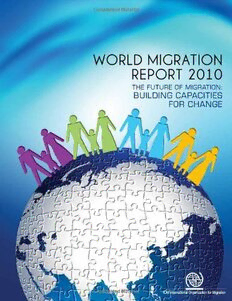Download World Migration Report 2010 - The Future of Migration: Building Capacities for Change PDF Free - Full Version
Download World Migration Report 2010 - The Future of Migration: Building Capacities for Change by International Organization For Migration in PDF format completely FREE. No registration required, no payment needed. Get instant access to this valuable resource on PDFdrive.to!
About World Migration Report 2010 - The Future of Migration: Building Capacities for Change
Migration is a constant and dynamic phenomenon increasingly requiring diversified policy intervention in order to maximize its potential benefits and minimize related costs for both countries of origin and destination as well as migrants themselves. Better knowledge and enhanced capacities in different policy areas are essential to ensure the protection of migrants, the facilitation of legal migration, the integration of migrants into the country of destination, the support for sustainable voluntary return and the greater interlinking between migration and development.The challenge remains in translating improved understandings into policy and practice on the ground. State capacities around the world for managing migration are limited. Legal frameworks may need to be updated or overhauled to focus on new areas of migration, or to handle new influxes or outflows of migrants; staff working on the front line may need equipment, training and support; civil society and migrants themselves may not be adequately integrated into the process of data-gathering and making and implementing policy; vulnerability factors and health risks inherent to the migration process need to be better understood and addressed.International migration is likely to transform in scale, reach and complexity, due to growing demographic disparities, the effects of environmental change, new global political and economic dynamics, technological revolutions and social networks. These transformations will be associated with increasing opportunities, exacerbate existing problems and generate new challenges.The World Migration Report 2010 provides a tool for self-evaluation in terms of future scenarios, and demonstrates the need for a far more comprehensive approach to capacity-building for migration than has typically been adopted. The aim is not to prescribe 'one-size-fits-all' policies and practices, but to suggest objectives of migration management policies in each area, to stimulate thinking and provide examples of what States and other actors can do.Part A of the report focuses on identifying core capacities in key areas of migration management, raising key concepts and outlining important examples of existing practices in these areas. Part B provides an overview of migration in the world today, from both the global perspective and through six regional chapters, drawn from the most up-to-date data.Table of Contents-IOM Editorial Team-Acknowledgements-List of WMR 2010 Background Papers-List of WMR 2010 Interagency Seminars-WMR 2010 Eurasylum's Monthly Policy Interviews-List of Figures and Maps-Foreword by IOM Director General William Lacy Swing-Building Capacities for Change-The global outlook for migration-Capacity-building-Labour mobility-Irregular migration-Migration and development-Integration-Environmental change-Migration governance-Next steps-References-An Overview of International Migration Trends-Introduction-Global overview of migration-Americas regional overview-Asia regional overview-Europe regional overview-Middle East regional overview-Oceania regional overview-Annex: Migration data: comparability, quality and limitations-Maps The International Organization for Migration (IOM)IOM is committed to the principle that humane and orderly migration benefits migrants and society. As an intergovernmental body, IOM acts with its partners in the international community to assist in meeting the operational challenges of migration, advance understanding of migration issues, encourage social and economic development through migration and uphold the human dignity and well-being of migrants.Our publications focus on topics such as: International Migration Law (IML)Migration and LabourMigration and Development
Detailed Information
| Author: | International Organization For Migration |
|---|---|
| Publication Year: | 2010 |
| ISBN: | 9789290685906 |
| Pages: | 295 |
| Language: | English |
| File Size: | 12.429 |
| Format: | |
| Price: | FREE |
Safe & Secure Download - No registration required
Why Choose PDFdrive for Your Free World Migration Report 2010 - The Future of Migration: Building Capacities for Change Download?
- 100% Free: No hidden fees or subscriptions required for one book every day.
- No Registration: Immediate access is available without creating accounts for one book every day.
- Safe and Secure: Clean downloads without malware or viruses
- Multiple Formats: PDF, MOBI, Mpub,... optimized for all devices
- Educational Resource: Supporting knowledge sharing and learning
Frequently Asked Questions
Is it really free to download World Migration Report 2010 - The Future of Migration: Building Capacities for Change PDF?
Yes, on https://PDFdrive.to you can download World Migration Report 2010 - The Future of Migration: Building Capacities for Change by International Organization For Migration completely free. We don't require any payment, subscription, or registration to access this PDF file. For 3 books every day.
How can I read World Migration Report 2010 - The Future of Migration: Building Capacities for Change on my mobile device?
After downloading World Migration Report 2010 - The Future of Migration: Building Capacities for Change PDF, you can open it with any PDF reader app on your phone or tablet. We recommend using Adobe Acrobat Reader, Apple Books, or Google Play Books for the best reading experience.
Is this the full version of World Migration Report 2010 - The Future of Migration: Building Capacities for Change?
Yes, this is the complete PDF version of World Migration Report 2010 - The Future of Migration: Building Capacities for Change by International Organization For Migration. You will be able to read the entire content as in the printed version without missing any pages.
Is it legal to download World Migration Report 2010 - The Future of Migration: Building Capacities for Change PDF for free?
https://PDFdrive.to provides links to free educational resources available online. We do not store any files on our servers. Please be aware of copyright laws in your country before downloading.
The materials shared are intended for research, educational, and personal use in accordance with fair use principles.

